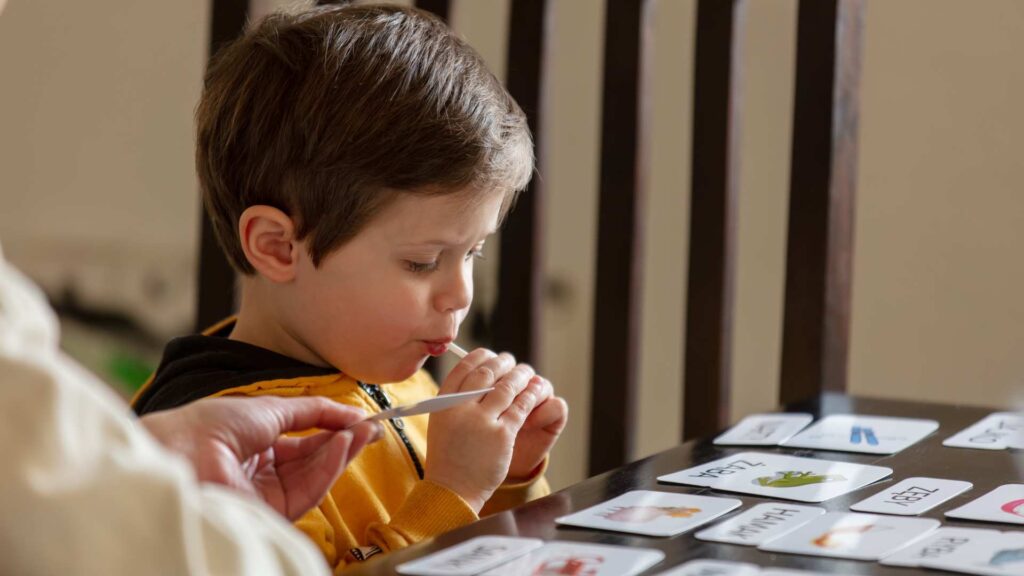Table of Contents
What is the difference between nonverbal and nonspeaking?
The power of words has guided human interaction throughout time, but not everyone experiences language in the same way. Individuals diagnosed with autism spectrum disorder (ASD) may have difficulty relating to traditional forms of speech, from expressing nonverbal cues to deciphering social nuances. In understanding autism, it has become clear that terms such as “nonverbal” and “nonspeaking” have distinct meanings despite their frequent interchange in conversation.
Communication and social interaction deficits are part of the diagnostic criteria for ASD. Although each individual on the spectrum is unique and experiences different signs, there are characteristic symptoms. For example, according to the National Library of Medicine, around 25 to 30% of children with ASD do not develop verbal language or have minimal language skills, using approximately 30 words.
Moreover, there’s a common misconception that nonverbal or nonspeaking individuals with autism lack intelligence or comprehension. This stereotype is not only inaccurate but also harmful. Many nonverbal and nonspeaking individuals have rich inner lives and unique talents that may not be immediately apparent. It’s crucial to challenge such misconceptions and instead embrace and respect everyone’s uniqueness.
At ABA Centers of America, in addition to promoting scientifically proven ABA therapy and autism care services, we aim to foster a more profound comprehension and acceptance of autism and all its implications and characteristics, such as nonverbal and nonspeaking communication within the spectrum. Let’s continue to explore and raise a greater understanding of the experiences of individuals with ASD.
Defining Nonverbal and Nonspeaking in Autism
At first glance, nonverbal and nonspeaking may appear synonymous, as healthcare providers used it in the past to describe individuals with ASD facing difficulties in communication, but they hold distinct meanings. So, let’s define what means each one:
Nonverbal
- Nonverbal typically refers to individuals who do not use spoken language as their primary mode of communication. These individuals may not rely on speech to convey their thoughts, feelings, or needs.
- Nonverbal individuals may communicate through other means, such as gestures, facial expressions, pointing, or other forms of body language.
- It’s essential to recognize that being nonverbal does not necessarily mean a lack of communication ability altogether; rather, it signifies a reliance on non-speech modalities for communication.
Nonspeaking
- Nonspeaking specifically denotes individuals who may not use speech but can communicate through alternative means.
- This term acknowledges that although verbal speech may not be present, there are still avenues for communication available to the individual.
- These alternative means of communication can include sign language, AAC devices, picture communication systems, typing, writing, or other forms of assistive technology.
- Nonspeaking individuals may have varying degrees of proficiency and preference in utilizing these alternative communication methods.
While both terms describe individuals who do not use spoken language to communicate, “nonverbal” generally encompasses a broader range of communication methods beyond speech. At the same time, “nonspeaking” explicitly highlights the use of alternative communication modalities in place of speech. Both terms underscore the importance of recognizing and supporting diverse communication abilities within the autism spectrum.
Understanding the Communication Challenges
Some individuals do not develop spoken language in their lifetime, others present a language delay as children, and others prefer to use the blackboard to communicate. Why do these communication difficulties occur in children with autism?
Individuals with ASD experience communication difficulties due to a complex interplay of factors that affect both verbal and non-verbal communication. According to the National Institute on Deafness and Other Communication Disorders, they may have the following communication characteristics:
Neurodevelopmental Differences: ASD is fundamentally a neurodevelopmental disorder, which implies that the brain’s development differs from typical developmental trajectories. These differences can affect various aspects of communication, including language acquisition, the understanding and use of nonverbal communication cues, and the ability to use language in a socially appropriate manner. Neurodevelopmental differences make it challenging for individuals with ASD to process and produce language in the same way their neurotypical peers do.
Challenges with Verbal Communication: Many individuals with ASD find it difficult to develop language skills and understand what others are saying to them. This difficulty can range from the complete absence of spoken language in some to subtle problems with the pragmatics of language—such as understanding idioms, jokes, or sarcasm—in those who are verbally fluent. The inconsistency in language development often results in an uneven skill set, where they may have a rich vocabulary in areas of interest but struggle with general conversational language.
Difficulty with Non-verbal Communication: Nonverbal communication, including gestures, eye contact, facial expressions, and body language, is often particularly challenging for some individuals with ASD. They might not naturally pick up on or interpret these cues, making it hard for them to read others’ emotions or intentions.
Social Interaction Challenges: The core symptoms of ASD include difficulties with social interaction, which directly impacts communication. Individuals with ASD might not recognize social cues that indicate when it’s their turn to speak or when a topic of conversation has changed, making social interactions feel awkward or confusing.
Sensory Processing Issues: Many individuals with autism have sensory processing issues, which can affect communication. Over- or under-sensitivity to sounds, lights, and other sensory inputs can make ordinary environments overwhelming or distracting, hindering their ability to focus on communication. Sensory overload can also lead to distress, making it difficult for them to communicate effectively.
Executive Functioning Challenges: Organizing thoughts, planning, and maintaining attention can further complicate communication for individuals with ASD and make it hard for them to follow conversations, stay on topic, or express their thoughts coherently.
Communication Alternatives for Individuals with ASD
Communication plays a crucial role in our daily interactions, typically involving verbal communication and gestures. However, individuals with autism may have difficulty using these traditional methods of communication. Therefore, it is important to explore alternative means of communication that extend beyond spoken words.

These alternatives may include:
- Augmentative and Alternative Communication (AAC): AAC involves using tools and methods other than speech to communicate. These devices could include picture boards, communication apps on tablets or smartphones, or apps that generate speech based on text or symbols.
- Sign Language: This language uses hand movements, gestures, and facial expressions to convey meaning. Many different sign languages are used around the world, with American Sign Language(ASL) being one of the most widely recognized.
- Visual Supports: Visual aids are tools that use pictures, symbols, or written words to help with communication. These can include things like visual schedules, choice boards, or picture cards to express wants and needs.
- Picture Exchange Communication System: PECS is a structured system that teaches individuals to communicate by exchanging pictures or symbols. For example, someone might give a picture card to someone to ask for something or to indicate how they’re feeling.
- Gesture and Body Language: Gestures, facial expressions, and body language can be powerful ways to communicate without using words. An individual might point, nod, shake their head, or use other movements to convey meaning.
ABA Therapy and Communication Skills
One of the primary concerns of parents of children on the spectrum is that their children may not be able to communicate, and they ask us if perhaps one day they will be able to speak. In these cases, the possibilities are always diverse. Still, we always advise that the earlier a child begins an Applied behavior analysis (ABA) therapy program, the more rapidly they can develop communication skills.
However, in our experience working with children with autism, techniques based on ABA have proven to be very effective in helping children develop their communication skills, including those with nonverbal and nonspeaking.
ABA therapy focuses on teaching skills systematically, using techniques such as positive reinforcement and repetition to help children learn new skills. With early intervention, children can develop a strong repertoire of communication skills, enabling them to interact more effectively with their environment and improve their quality of life.
For nonverbal individuals and those with speech difficulties within the spectrum, ABA therapy can focus on specific communication skills, such as the use of augmentative and alternative communication systems, understanding gestures and signals, and improving joint attention and social skills related to communication.
ABA Centers of America Helps You Navigate Autism
We are continuously learning more about what the spectrum can encompass and what the neurodiverse community experiences. Understanding that everyone has unique abilities and ways of communicating, we can build a more empathetic and inclusive society.
In that support, ABA Centers of America, through individualized and carefully designed ABA programs, have helped families in New Hampshire and Massachusetts increase the communication capacity of nonverbal and nonspeaking individuals, providing them with tools to express themselves, interact with others, and participate more fully in their environment.
Don’t let your child’s communication type hinder their ability to connect with others. Call us at (844) 923-4222 or schedule a free consultation and learn about the positive impact personalized therapies can have on your neurodivergent child’s overall development.







